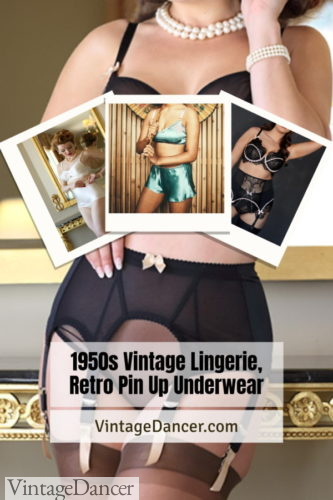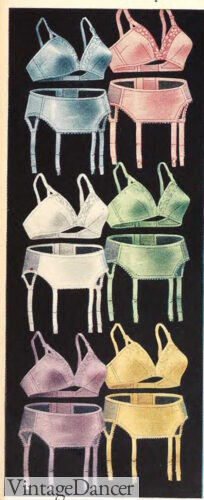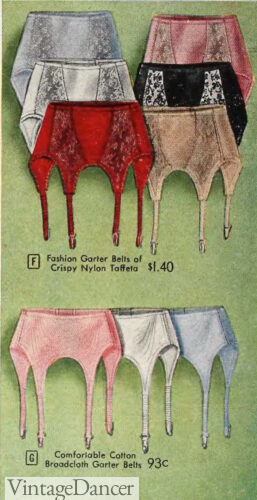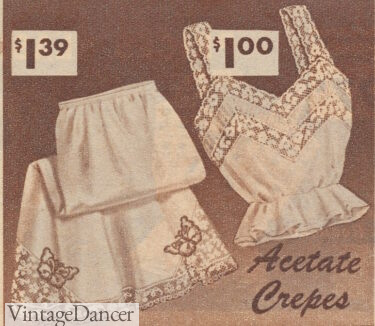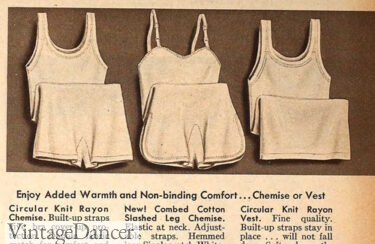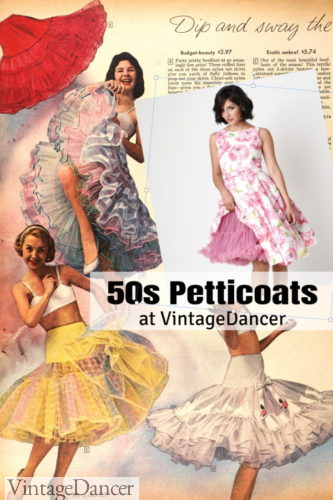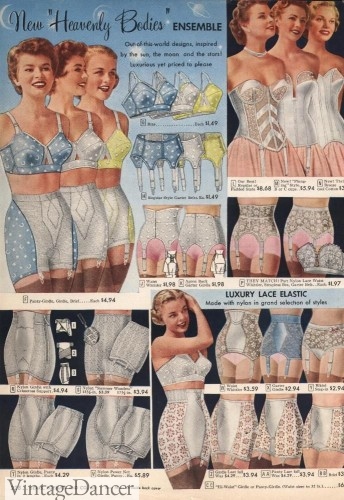
1958 Lingerie – Panty girdles, bras and Merry Widow corsets
The 1950s were all about glamour, and Hollywood’s Golden Age stars were setting trends that every woman in America was after. Think Jane Russell, Lana Turner, and Marilyn Monroe. Big breasts, big hips, and small waists were a must– and if you didn’t have them naturally on your own, not to worry– there was some 1950s lingerie for that.
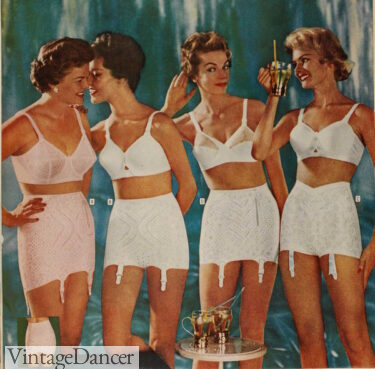
1959 bra and girdle sets- a must for the 1950s silhouette
The hourglass silhouette of the 1950s happened thanks to the lingerie of the time. To achieve the desired fit and look of clothes on the outside, it was important to have the correct garments underneath to push up or flatten down areas of the body that needed to be pushed or flattened.
There were many styles of lingerie include bras, panties, slips, petticoats, girdles, stockings, and garters.
1950s Lingerie: Bra
There were many different styles of 1950s lingerie bras to choose from in the ’50s. Strapless, longline and bullet bras were among some of the most popular, just to name a few.
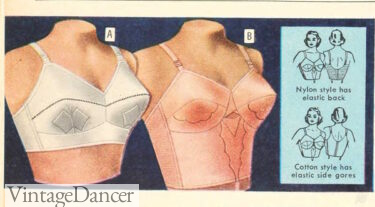
1950 short and longline bras
The 1950s silhouette demanded bigger busts to balance out the required big hips. Instead of a natural 1940s bra that separated the breasts towards the sides, the 1950s bra pushed the breasts in, up and out to new extremes. Bigger was better.
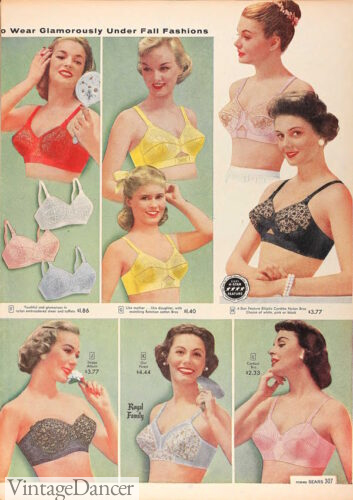
1957 bras for women and teens
1950s bras were either made of cotton, nylon or rayon and ranged from about $0.98- $2.50 depending on the fabric and the design. To add some glamour, bras could have taffeta trim, floral prints, lace, elaborate stitching, or accent bows.
Elastic wasn’t always as durable and reliable as it is today, so caring for your lingerie was especially important. Hand washing was a must!
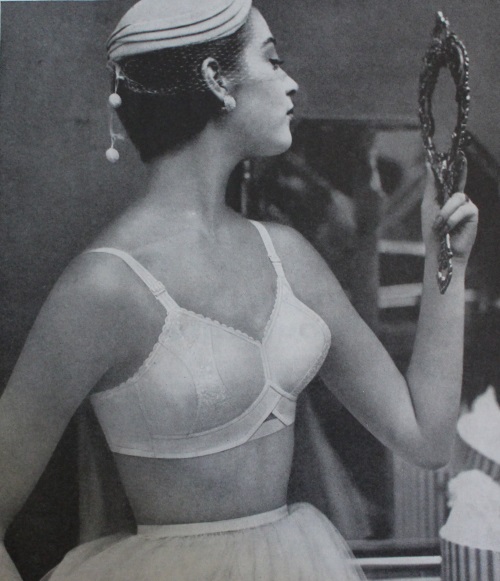
1955 classic bra
Long line bras were especially popular because they were said to “slim the diaphragm, control and uplift.” They were usually strapless with uplifting cups and boned support down to the middle waist. With a low back cutout, they also made it possible to wear strapless gowns or halter top dresses.
They were often paired with girdles or corsets for complete tummy control. Some had corset hooks or girdle tabs that attached to the inside top of the corset to prevent them from separating.
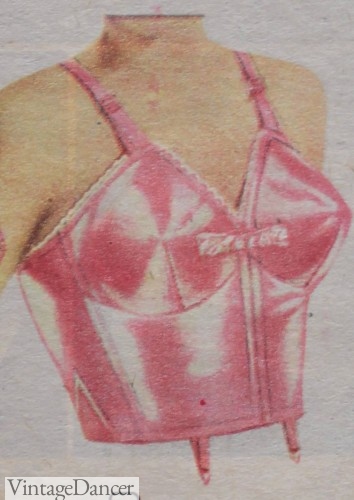
1952 Pink longline bra with corset hooks/tabs
Strapless Bra – One of the more expensive styles was the convertible bra, which is still popular today, that had straps that could be taken off. Many strapless bras had latex on the inside and “stay-up boning” that were supposed to prevent your bra from slipping down.
For extra cleavage, bra cups were reduced to 3/4 or 1/2 cups (eh hem, the push up bra?).
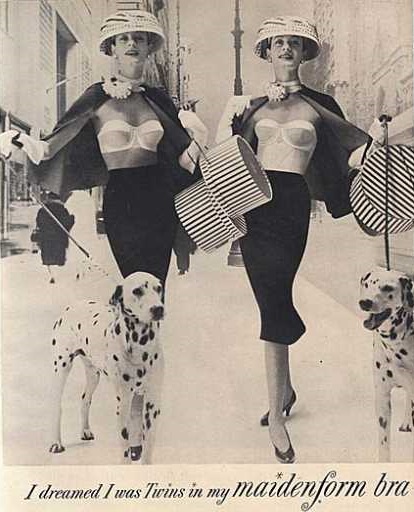
1956 strapless Maidenform bras in regular and longline
The pointed bra, whirlpool bra, bullet bra, or sweater girl bra remained popular throughout the late ’40s and ’50s due to the ultra feminine look.
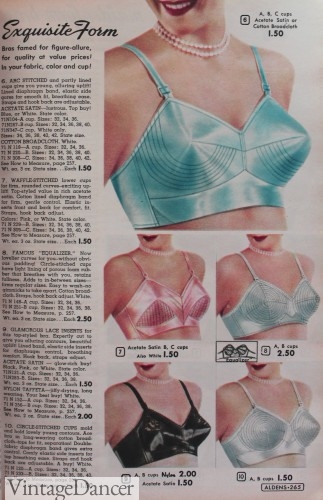
Pointed bras, aka Bullet Bras
The pointed, pre-formed, conically stitched and padded bra is what gave the breast a false point and enhanced weight. Without the protruding bullet shape, most 1950s dresses, blouses and snug knit sweaters would be ill fitting.
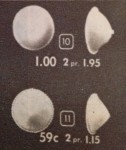
Falsie breast inserts with and without nipples
The foam rubber breast falsie complete with pointed nipple were more popular than women would admit to owning. They gave shape and volume to women who lacked it naturally.
Falsies had their downsides, though. Poor quality rubber absorbed odors and disintegrated quickly. Some came covered in satin and lace to make them prettier. The alternative was a padded cone that, unfortunately when worn and bumped into, went flat. There was no dainty way to pulling the point back out again.
The inflatable bra was another option, but was also prone to bursting under pressure. Oh the embarrassment!
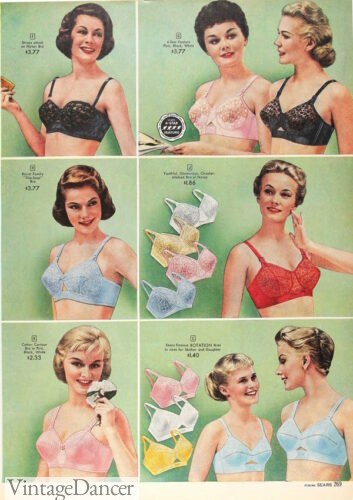
1958 bra styles for women and girls
1950s Bra Recommendations:
Make your Own Bullet Bra – Step by step tutorial and pattern from VavoomVintage. For any size bust!
Bullet Bras by Secrets in Lace – Satin, lace or sheer up to 44DD
Bullet Bra by What Katie Did – Up to size 38D
Satin Bullet Bra by Secrets in Lace – Up to 42DD
You local lingerie store may have a a bra in the 50s style. Look for “old lady” bras sold in boxes or bags. Some “retro style” bas have the 50 look but may not have the prefect, pointed 50s shape. Look for bras with stitched lines for structure instead of a smooth cup.
1950s Lingerie: Panties
1950s underwear, called panties, were high waist briefs with an elasticized waist and leg bands. Think granny panties, and you are right on target for the ’50s.
They were not snug fitting, although a plain pant was needed for tight-fitting pencil dresses whereas ruffled and decorated panties were fine under full skirts.
The open leg tap pant continued to be sold to women but more ladies were enjoying the brief style underwear.
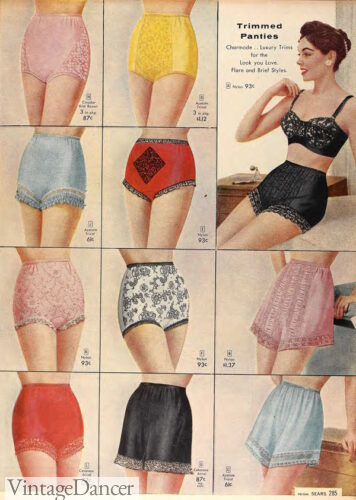
1957 lace trim panties
Briefs and panties with the smoothest fit were meant to eliminate the need for a sanitary belt and give you comfortable protection. Panties were available in either white, nude or pastel colors like baby blue, pink, mint green, and yellow. Some youthful panties also featured prints.
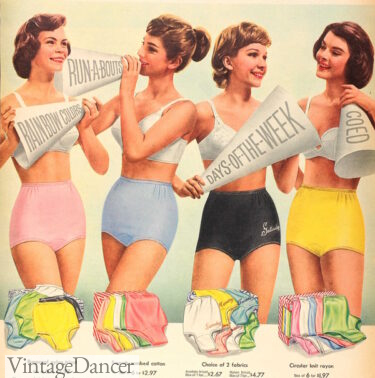
1959 cotton panties ( granny panties)
Panties were made of cotton knit, rayon or satin. Trimmings were lace, embroidery, and ruffles.
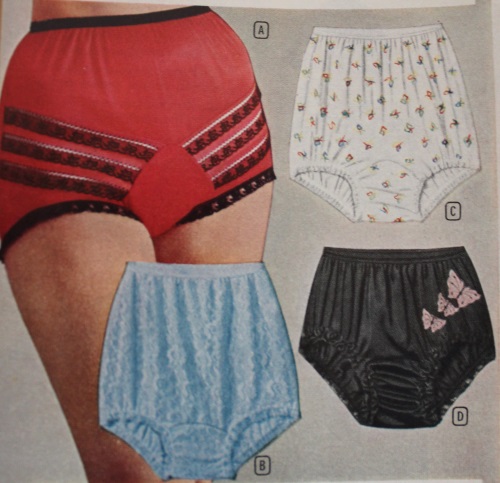
1957 decorated panties, cotton print panties, blue lace panties and black satin panties with butterfly embroidery
Secrets in Lace panties – Full panties and sexy panty style.
Granny Panties – Any full coverage, high waisted cotton or satin panty is in the style of the ’50s.
1950s Lingerie: Corsets
The corset was essential to achieving the perfect ‘50s figure, but it definitely wasn’t built for comfort! There was a wide variety of corsets worn during the decade in combination with a bra, girdle or panties. The steel boning used in the past was gradually replaced with plastic and celluloid, and zippers took over for hook and eyes in the back, making them at least easier to get in to.
The full corset covered the entire torso, and included bra cups and straps. A full corset would either stop at the waist or extend down several inches below. Later in the decade the 2-way stretch corset was introduced, which had to be rolled on. It was combined with a girdle for full-body shaping.
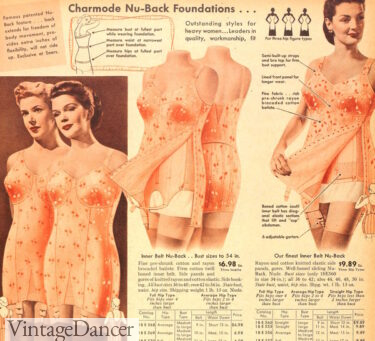
1950 full body, two layer corselet
The corselet today was a more modern version of the corset with an attached bra. They nipped in the waist and hips, smoothed the tummy, and raised the bust up with padded 1/2 or 3/4 cups.
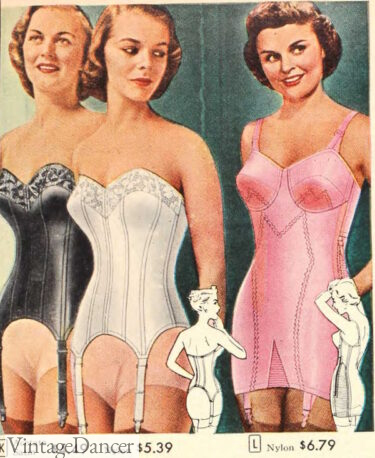
1952 merry widow (strapless) and full body corselet
The strapless corselet was called the Merry Widow, after a movie of the same name. The name Merry Widow is used instead of corselet today.
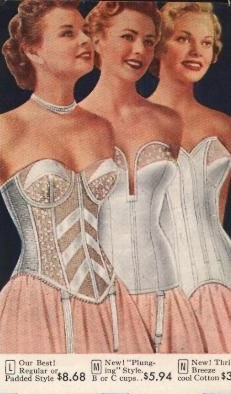
1958 merry window corsets
The ‘waspie’ was a popular corset during the ‘50s. It was about 8 inches wide, and pulled in just the waist. It was very rigid and gave a lot of shaping. This type of corset was the most fashionable and often used underneath designer clothing. It had to be combined with a long-line bra, girdle and hip padding to get the perfect hourglass look.
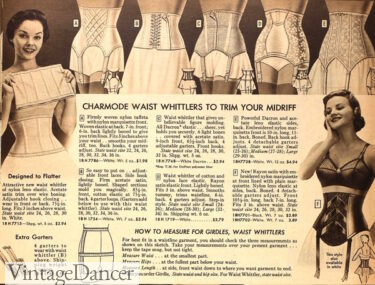
1956 waist shapers / waspie/ nippers/ underbust corsets or girdles
Corset Recommendations:
Overbust Strapless corset – Full Hip Corset by Violet Vixen or CS-530 by Orchard for waist control.
Underbust corset/ Waist cincher – Orchard #Cs-411 or CS-201.
1950s Lingerie: Girdles
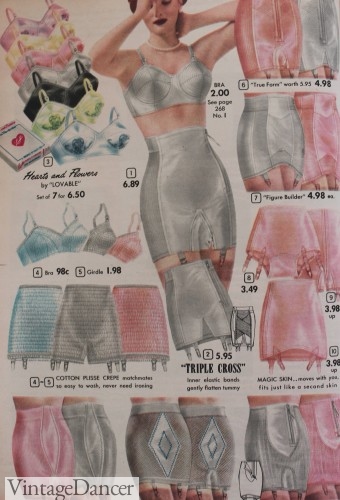
1952 Skirt and Panty Pullon Girdles
1950s girdles were still a required undergarment for most dress and even pant shapes of the 1950s. They were preferred over corsets by most women.
The slim fitting sheath dress, AKA wiggle dress, would expose a woman’s bumps and rolls if it were not for the slimming effect of the mini skirt shape girdle.

1956 “Action” girdle
The skirt only came down to the mid thigh so that women could still walk and sit freely. In the mid 50s, the sarong style dominated the market. It had a to panels that crossed in the center of the legs making them even easier to walk in.
The most comfortable was the legged girdle, called a panty girdle. Short or long legs both slimmed the hips and thigh. Most modern shapewear is based on the panty girdle style.
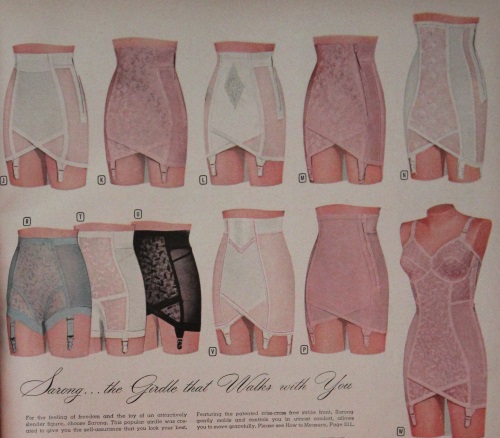
Sarong girdles- criss cross front to make making easier
The fluffy swing dress of the 1950s didn’t need a full girdle, but a short low waist girdle kept the hourglass shape intact.
Even slim cigarette pants and capris benefited from long leg “panty girdles”. Girdles almost always had garter snaps, two in the front and two in the back. They often had zippers for an easy on and off and were made of light knit nylon and cotton covered “Lastex.”
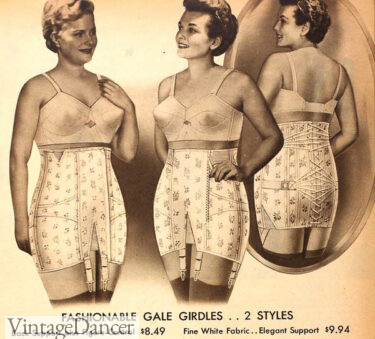
1956 full figure girdles with elastic panels, adjustable ties, and zipper opening
Girdles for fuller figures often had boning, wires, and stiff fabric reinforcements. Even with all the support, the consumer demanded lighter and more breathable corsets.
“Young or mature, women made their complaints about girdles known, because companies repeatedly trumpeted improvements in comfort. Several firms began to cut the lower front edge in a high upward curve to reduce discomfort in walking. Sarong famously brought out a crisscrossed lower front to move with the wearer’s stride. Legs of panties were redesigned for ease in wearing, and both top and bottom of the rear of the girdle were engineered to prevent riding up—a major lament. Removable, even disposable, crotches remedied the panties’ laundry problems.” – A to Z Fashion, Jane Farrel- Beck
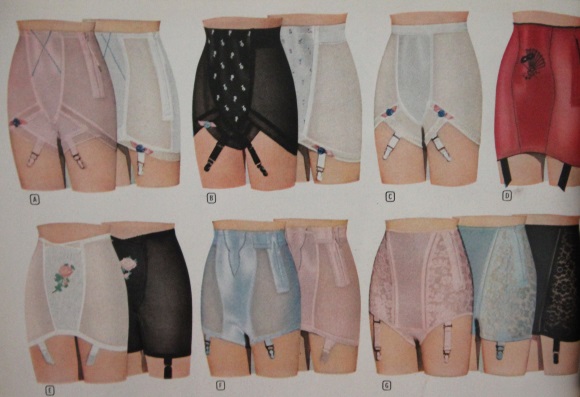
Mid 50s girdles
New fishnet mesh fabrics helped with circulation, and improved Nylon fabrics reduced weight. By 1959, DuPont made a 2 ounce girdle, which is about the same weight as a Spandex body shaper today. In extreme summer weather, women simply went without a girdle and wore less confining dresses such as the blouson, empire waist shift or the chemise.
1950s girdles explored new colors for lingerie. No longer just white, basic girdles came in off white, almond, light gray, bold red, purple, and even salmon pink. Floral embroidery, lace and appliques added beauty to the girdle. Prices ranged from $2 to $25 for a top of the line girdle.
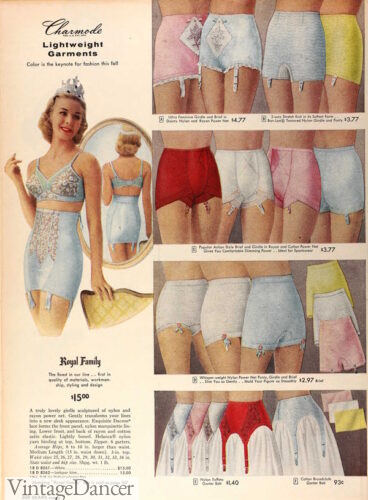
1957 lightweight panty-girdles (panties with attached garter straps) would lead lingerie trends into the 1960s
How to Put on a Girdle (1950s Advice)
To easily get into your girdle, it is recommended that you dust your body with talcum powder to allow the girdle to slip on more easily– especially in the hotter months. Put on cotton panties first.
For a step-in girdle, fold it over 2 to 3 inches at the waistline and ease into it finishing off with rolling up the fold to meet your waistline.
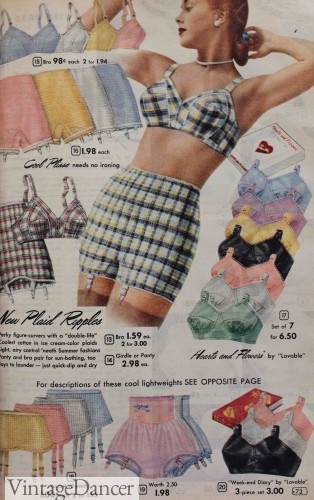
1950s Colorful Lingerie- plaid? Why not.
Girdle Recommendations:
Rago Full Body shapewear – Bust to hip control.
Rago Open Button Girdle – With garter clips.
High waist panties with tummy control panel are my favorite.
1950s Lingerie: Garter Belts
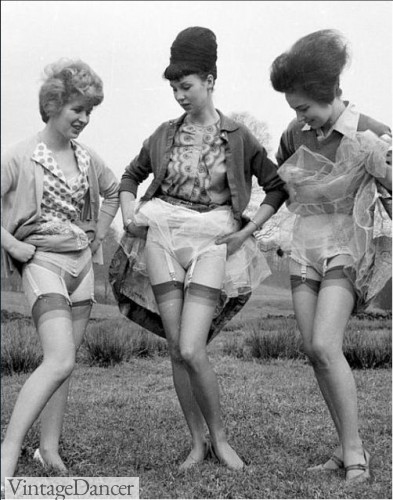
Gasp! These ladies are showing off their garters
Most corsets, corselets, girdles and panty-girdles came with attached straps to hold up 1950s stockings. For some women who chose not to wear any of these shaping devices, a garter belt was used alone.
It was a simple, short girdle with straps for the stockings. Some were thin and light, while others were wide and elastic so as to provide some shaping support. It was mostly for naturally thin women and teens that chose to wear a garter belt by itself.
- 1950 matching bar and garter belt
- 1958 plain or lace garter belts
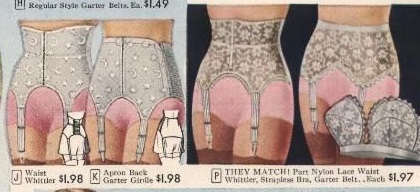
1958 lace garter belts with tummy support
Do you wear a garter belt over or under panties? The secret to getting them to not slide down panties is to wear them under panties against the skin. Vintage illustrations could not modestly demonstrate that which is why you see them place over panties.
1950s Lingerie: Slips and Petticoats
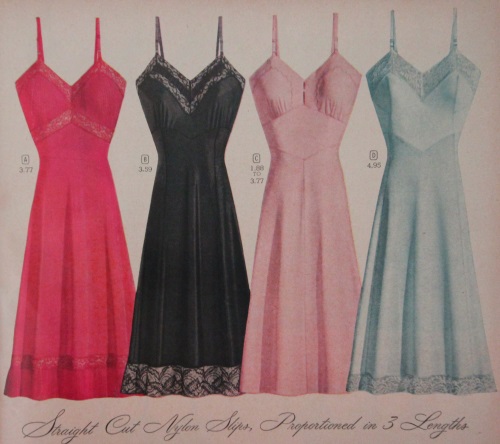
Nylon Slips
Beautiful and luxurious, the slip was firmly woven from quality cotton or rayon crepe or rayon satin with rich lace, fancy eyelet, ruffles, pleats, embroidery, or applique. Slips came in full lengths, down to the knee, or half lengths, from waist to knee.
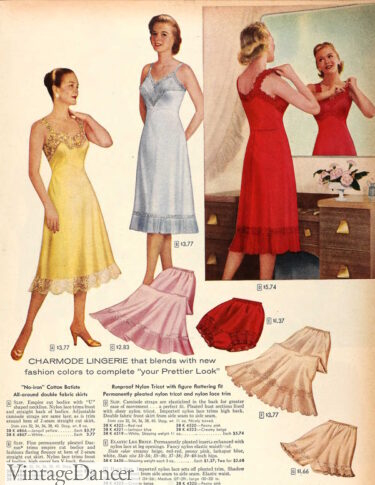
1957 full and half slips, ruffled pettipants
Half slips were worn with one piece dresses, while two piece suits or separates were worn with a full slip.
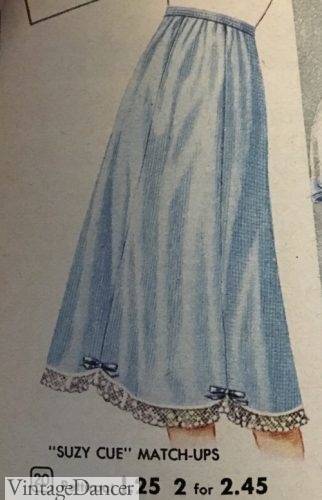
1950s Half Slip
A full slip should cover the bra completely and should not show under clothing. 1950s slips usually had thin adjustable straps. Common colors were pink, peach, light blue, navy, yellow, Nile green, black and white. Their beauty rivaled that of 1950s nightgowns.
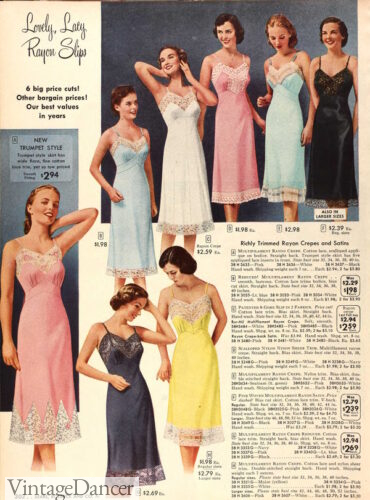
1952 pretty dress slips
Camisoles were the top half a slip or a knitted vest (tank top style) that were worn under sheer blouses. They could be paired with a half slip for skirts and dresses or worn alone when paired with shorts and pants. Knit union suits (a romper or long johns) could also be worn as an underlayer for sheer clothing.
- 1955 lace trim half slip and camisole
- 1957 knit one peice chemise (union suit) or vest (tank top)
Petticoats or crinolines were usually rayon, cotton or taffeta and had a detailed hem with maybe lace, ribbons, bows, or eyelet cutouts. Usually white, petticoats were tea-length or shorter depending on what style dress was going to be worn over it.
The hem is one of the most important parts of the petticoat, mostly because there was a chance it might be seen, so of course it had to be cute. Ruffles, floral designs and bows were often the accents on hems.
Many slips added the petticoat bottom ruffles into one garment. Learn more about and shop for 1950s petticoats.
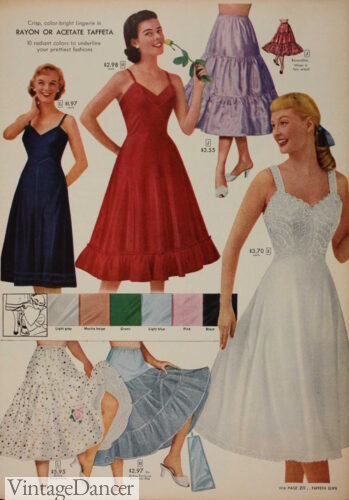
1956 petticoats and full slips
How to wear a slip: In the 1950s, it was recommended that you put a slip or petticoat on over your head so as to ensure that any straps did not break. A slip should fit over the bust and be long enough to meet the hem of the dress.
If a slip or petticoat can be seen underneath your garment, they should be shortened at the hem. White or light slips work best for most clothing, while a dark slip is needed for dark blue or black clothes.
When buying petticoats don’t go cheap. The cheaper the more itchy the material. You can wear a slip under the petticoat or a pair of yoga shorts to stop some of the itching. Otherwise buy a more expensive and softer nylon petticoat. I like Malco Modes.
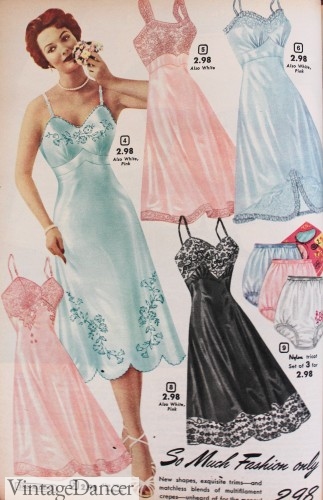
Embroidered and lace slips- my favorite!
1950s Winter Lingerie
All of the above lightweight nylon fabrics were ideal lingerie for summer and mild winter climates. However, a significant population lived through very cold winters and needed warmer lingerie.
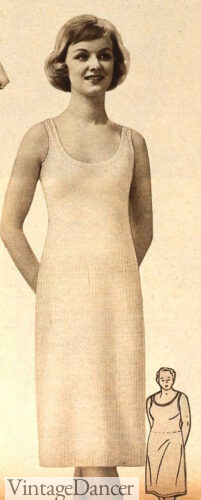
Most panties (with longer legs) and slips were sold in knitted cotton or wool materials. They were the same styles that women had been wearing for the past 100 years. Not pretty, but very functional.
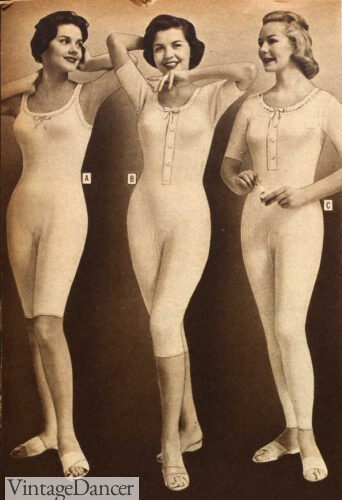
1958 winter union suits
Union suits later called long johns or thermals were full body one or two peice sets of kitten long underwear. They could have full legs and arms or shorter, knee length legs and strapless arms.
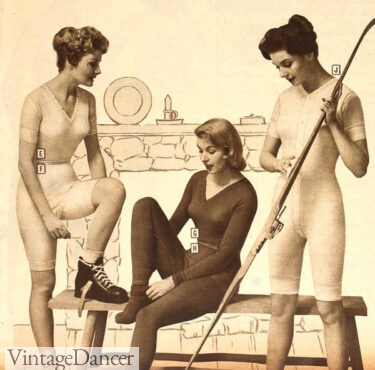
1958 knit wool or cotton winter underwear sets
In addition to knitted long underwear, 1950s women wore wool stockings or tall socks, full nylon petticoats (these are very warm), flannel petticoats, long panties (drawers), multiple slips (under and over a petticoat), and camisoles. All of these layers meant wearing dresses in a larger size and longer lengths and topping them with a very warm winter coat. Read Vintage Winter Outfits- Ideas to Keep Warm for more tips.
Shop 1950s Style Lingerie
Buy 1950s Vintage Lingerie, Retro Pin Up Underwear
1950s Crinoline Skirts | Crinoline Slips | 1950s Petticoats
Vintage Style Bras | Classic Bra, Old Style Bras
Seamed Stockings, Nylons, Tights
Vintage Lingerie Sewing Patterns
Retro Lingerie Brands- Where to Shop Vintage Style Lingerie
Debbie Sessions has been teaching fashion history and helping people dress for vintage themed events since 2009. She has turned a hobby into VintageDancer.com with hundreds of well researched articles and hand picked links to vintage inspired clothing online. She aims to make dressing accurately (or not) an affordable option for all. Oh, and she dances too.
